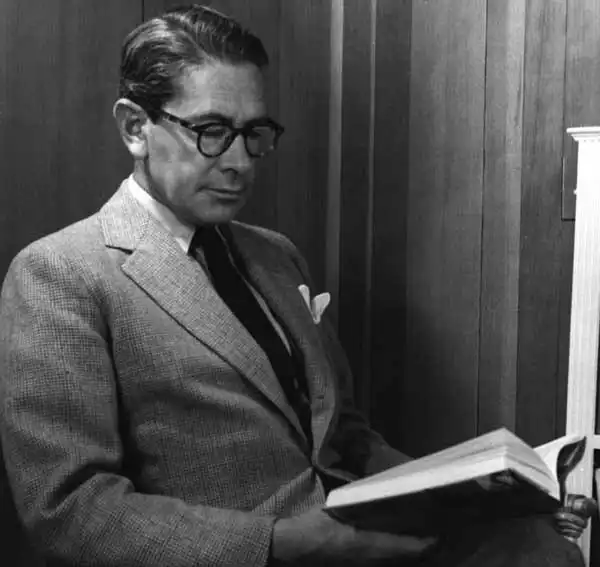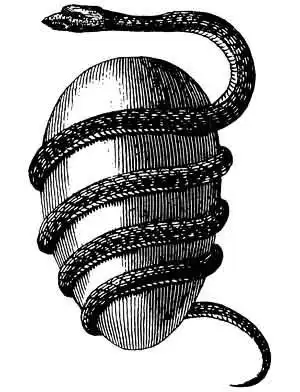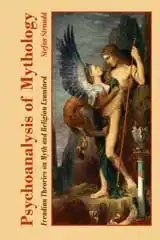Joseph L. Henderson
His theories about mythology and religion examined by Stefan Stenudd
His writing through the years consists mainly of articles in Jungian journals and chapters in anthologies, but there are two books of his own:Thresholds of Initiation from 1967 andCultural Attitudes in Psychological Perspective from 1984. Together with Maud Oakes he wrote The Wisdom of the Serpent in 1963, where his contribution was the introduction of some 70 pages. He also wrote a chapter of about 50 pages in Jung’s Man and his Symbols from 1964. Henderson devoted much of his writing to the subject of initiation in the light of analytical psychology, which would bring him closer to rite than to myth, but in Jungian tradition the two are mainly understood as expressions of the same psychological processes.
Reading DreamsBefore his death in 1961, Carl G. Jung invited Henderson to write a chapter in Man and his Symbols, an honor only three others shared with him. The book was published in 1964 and has been in print ever since, in several languages. Jung was the editor of the book and his own chapter in it was the last text he wrote before his death.Henderson’s chapter, “Ancient myths and modern man,” treats the hero myth as a symbolical representation of the steps people need to take for their psychological development towards complete adults. He has quite a specific description of the hero tale, which he regards as universal:
Henderson’s description is far too specific, applicable to some but not all heroes. What they may all have in common is some extraordinary capacity, not necessarily strength, and a grand quest that may or may not include the victory over some mighty foe, who does not have to be evil. That is enough of a definition for hero tales: remarkable persons on spectacular quests. Like Jung, Henderson has twisted the definition to fit the archetypal patterns he wants to find. Doing so, he sees the hero tale show a process in which “the image of the hero evolves in a manner that reflects each stage of the evolution of the human personality.” There are four such stages, or cycles, which he labels according to Paul Radin’s study of Winnebago hero myths: the Trickster, Hare, Red Horn, and Twin cycle.[3] In the book Henderson refers to, Winnebago Hero Cycles from 1948, Radin has the following definitions, all relating to the concept of libido: the Trickster represents the undifferentiated libido, the Hare the partially and imperfectly differentiated libido, the Red Horn the well differentiated libido, and the Twins the integrated libido. He calls the four periods “the primordial, the primitive, the Olympian and the Promethean.”[4] He goes on to state that the Trickster is totally non-moral and non-purposive, the Hare only secondarily moral and purposive, the Red Horn almost completely moral and purposive, and the Twins symbolize man’s mastery of the world. Radin doesn’t define libido, but his use of it strongly suggests that he refers to Jung’s rather than Freud’s application of the term, i.e., not just a sexual urge but urge as such, the passionate longing. In his introduction, Radin discusses the theories of both Freud and Jung, with particular respect for the latter. He insists that the new lines of inquiry they have initiated should be utilized, although he personally disagrees fundamentally with the viewpoints, the methods and the conclusions of Freud and Jung as well as their followers.[5] That did not stop him from later spending a few years in Switzerland and cooperating with Jungians. Henderson applies the four Winnebago cycles to his definition of the hero tale stages, and does so by interpreting dreams patients of his have described. He sees the same pattern there, which he takes as evidence of its existence. To him, as to all his fellow analysts, dreams are keys to the psyche and to its needs:
What is certain is that dreams extracted in this manner can’t prove any theory navigating the search for them. The very idea of someone’s dream making no sense until explained by another person is close to preposterous. It makes dream analysis unfalsifiable, which also means it is improvable. That may seem like a haven for the analyst, but it is at the cost of credibility. Already the first dream Henderson presents displays this flaw. In it, a guide explains things to the dreamer, and Henderson concludes that this guide is presumably his analyst. But he fails to consider how this may have influenced the dream or the patient’s recollection of it. Since all the dreams he uses in his reasoning are from his patients, they share the same weakness. To Henderson, the transformation process described by the four stages ends in death and rebirth, after which it is completed. That is what he sees as the function of initiation rites:
He claims that “the sacred marriage as an archetypal form has a particularly important meaning for the psychology of women, and one for which they are prepared during their adolescence by many preliminary events of an initiatory character.”[9] That could definitely be discussed also at the time of his writing. As for the Beauty’s commitment to the Beast, he told a woman having a dream which he connected to the tale:
The dream of the woman, leading to Henderson’s advice, he relates in the following way:
Repeated InitiationThe subject of initiation in the light of analytical psychology was one Joseph L. Henderson returned to repeatedly, describing it as a process of consecutive archetypes. The above-mentioned text was published in 1964, but existed at least as a draft in 1961 when Jung approved it.[11] Already in 1939, he wrote a paper on the subject for the Analytical Psychology Club of New York City, titled Initiation Rites, and in his introduction to the 1963 book The Wisdom of the Serpent, co-written with Maud Oakes, he treated initiation as a theme in myths. In 1967 his book Thresholds of Initiation was published.His view on initiation was consistently that of the ritual as death and rebirth. The old personality needs to die for the transformed person to emerge, as in childhood replaced by adolescence, the most significant of the rites of passage, which is often performed with ingredients of both pain and blood. So far, Henderson’s analogy makes sense. It gets less convincing when he applies Jungian theory to it all. Mainly, the archetypes are superfluous in explaining the form and function of initiation. Henderson’s perspective is that of a therapist, not an anthropologist. He is focused on how the concept of initiation can be applied to the treatment of patients, and his major method is dream analysis. This does inevitably turn his attention from a social to an individual understanding of initiation, although as a rite it is obviously socially upheld and performed. But he removes the rite of it and replaces it with an individual process towards increased maturity, akin to a school with only one pupil — and one teacher, being the analyst. That is expressed in the idea of its goal being individuation, a tell-tale term for this perspective:
The Jungian concept of the collective unconscious gives the impression of a social perspective, but that is misleading. This hidden part of the mind is supposed to share material common to us all, but its function is again strictly personal. It speaks internally to the individual, its symbolic language giving clues to the self-realization of individuation. The Jungian idea of the psyche is at the core solitary, in spite of its features being common to us all. But by devaluing the social aspects, only half of what we are remains.
Fear of DeathThere is one sentence by Henderson that demands attention. It is from the book The Wisdom of the Serpent, which he co-wrote with the ethnologist Maud Oakes in 1963, wherein a number of myths are presented as examples of initiation. As the subtitle specifies, the initiation pattern is explained as a process through death to a new life:The Myths of Death, Rebirth, and Resurrection.In the introduction, Henderson discusses the fear of death, which to him is “at bottom the ego’s fear of the unknown.”[13] That is one way of describing it, though hardly the whole truth. It is not necessarily what might be on the other side of death that scares us, but the unavoidable prospect of dying. We want to keep it off as long as we can. Only a small minority welcomes it — and that is not because they look forward to death, but because they find life miserable. So, our attitude towards death is not as much about the unknown as it is about the life we know. Still, those words by Henderson are not the ones standing out the most. It is what ha says on the next page, to explain why the fear of death is not at all about death:
Of course, that does not mean we don’t fear change, growing up, and thousands of other things. But the fear of death is definitely one of them — the big one — and has been so for as far back as recorded history takes us, and in every known culture. It is what lies at the core of most religions, and the gnawing frustration that frequently muddles our emotions and actions. Not long after we are born, we learn that we will die, and there is no way around it. We don’t even know when. It is hard to enjoy life fully, when knowing it can be snatched away from us at any moment. It may be that the great lesson to be learned in life is to come to terms with the fact that it ends. But that is far from Henderson’s idea of archetypes setting off a series of initiations leading to individuation. Even if such a process is successfully completed, so that the conscious is aware of the unconscious and at peace with it, the prospect of death is unchanged — and so is the fear of it.
[1] Thomas B. Kirsch,The Jungians: A Comparative and Historical Perspective, London 2000, p. 80. [2] Joseph L. Henderson, "Ancient myths and modern man," Carl G. Jung & Marie-Louise von Franz (ed.), Man and his Symbols, New York 1964, p. 110. [3] Ibid., p. 112. [4] Paul Radin,Winnebago Hero Cycles: A Study in Aboriginal Literature, Baltimore 1948, p. 8. [5] Ibid., pp. 7f. [6] Jung & von Franz (ed.) 1964, p. 107. [7] Ibid., p. 116. [8] Ibid., p. 130. [9] Ibid., p. 136. [10] Ibid., p. 137. [11] Ibid., p. 11. [12] Joseph L. Henderson, Thresholds of Initiation, Middletown 1979 (first edition 1967), p. 19. [13] Joseph L. Henderson & Maud Oakes, The Wisdom of the Serpent: The Myths of Death, Rebirth, and Resurrection , Princeton 1990 (first edition 1963), p. 3. [14] Ibid., p. 4f.
Jungians on Myth and Religion
This text is an excerpt from my book Archetypes of Mythology: Jungian Theories on Myth and Religion Examined from 2022. The excerpt was published on this website in January, 2023.

MYTH
IntroductionCreation Myths: Emergence and MeaningsPsychoanalysis of Myth: Freud and JungJungian Theories on Myth and ReligionArchetypes of Mythology - the bookPsychoanalysis of Mythology - the bookIdeas and LearningCosmos of the AncientsLife Energy EncyclopediaOn my Creation Myths website:
Creation Myths Around the WorldThe Logics of MythTheories through History about Myth and FableGenesis 1: The First Creation of the BibleEnuma Elish, Babylonian CreationThe Paradox of Creation: Rig Veda 10:129Xingu CreationArchetypes in MythAbout CookiesMy Other WebsitesCREATION MYTHSMyths in general and myths of creation in particular.
TAOISMThe wisdom of Taoism and the Tao Te Ching, its ancient source.
LIFE ENERGYAn encyclopedia of life energy concepts around the world.
QI ENERGY EXERCISESQi (also spelled chi or ki) explained, with exercises to increase it.
I CHINGThe ancient Chinese system of divination and free online reading.
TAROTTarot card meanings in divination and a free online spread.
ASTROLOGYThe complete horoscope chart and how to read it.
MY AMAZON PAGE
MY YOUTUBE AIKIDO
MY YOUTUBE ART
MY FACEBOOK
MY INSTAGRAM
MY TWITTER
STENUDD PĹ SVENSKA
|
 Archetypes of Mythology
Archetypes of Mythology Psychoanalysis of Mythology
Psychoanalysis of Mythology